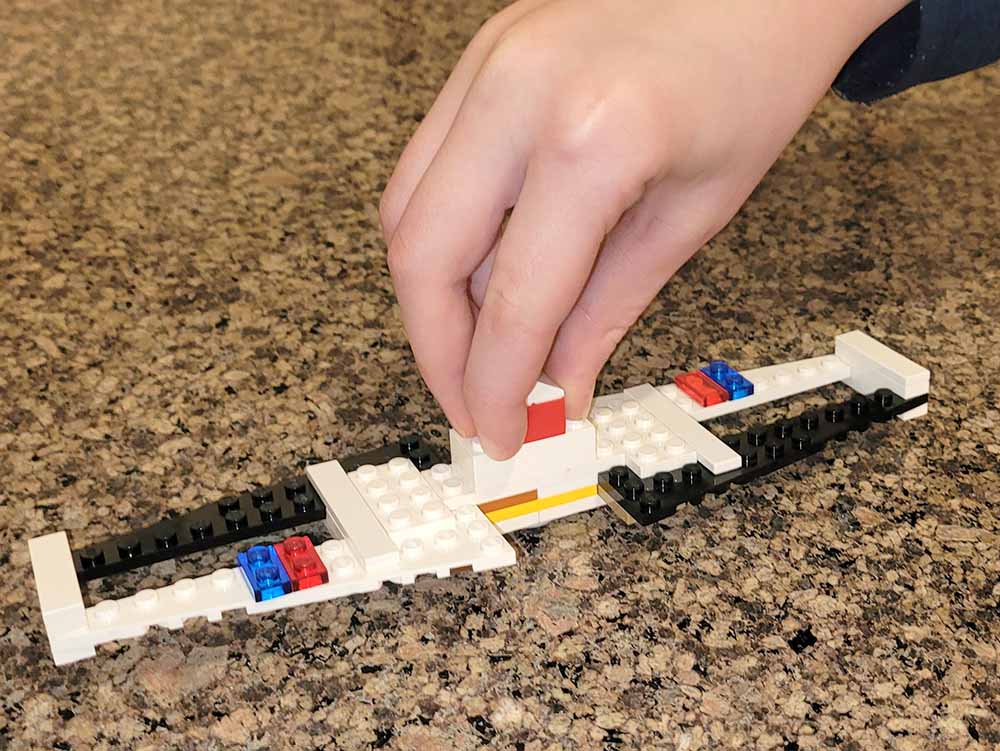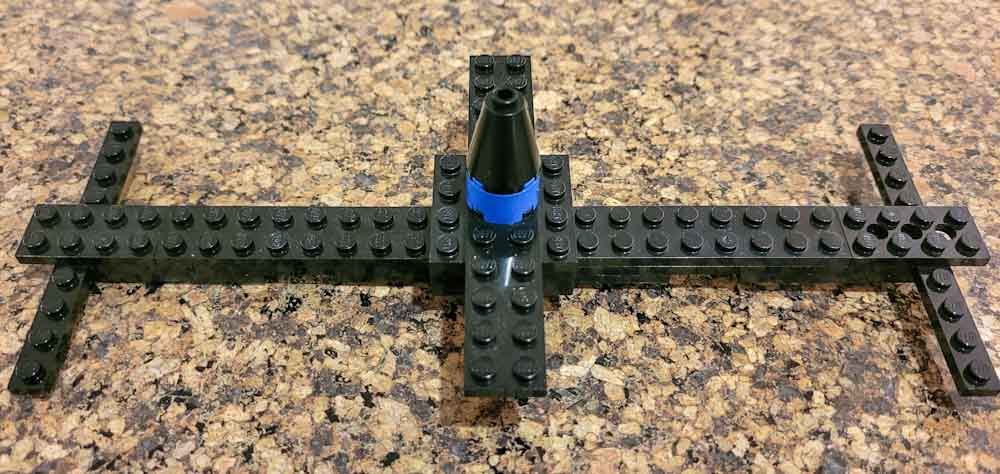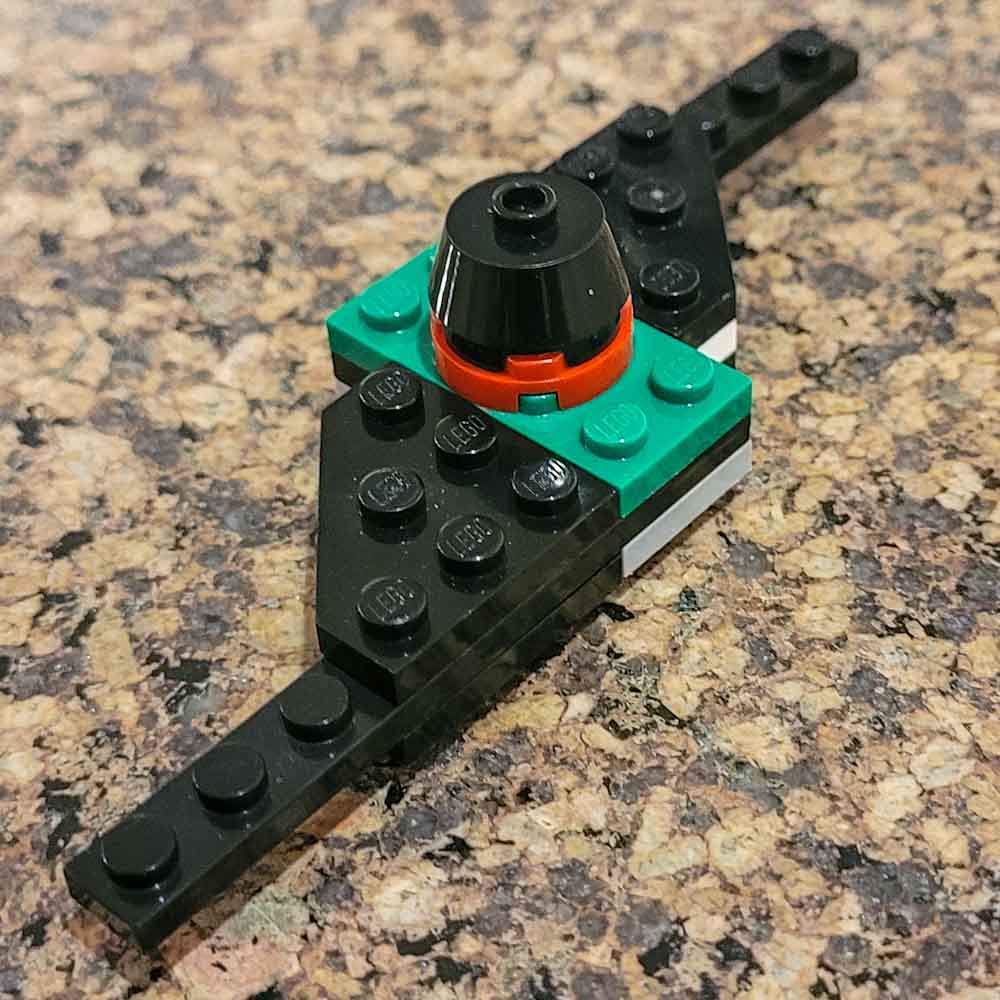
In the previous article, I introduced Brick Spinners. Brick Spinners are made from toy building bricks, and feature a rounded 2×2 plate (a Spinny-Thingy) on the bottom to allow them to spin on hard surfaces. Spin two of them towards each other, and enjoy the subsequent crash.
In this post, we discuss optimal designs for a Brick Spinner. If you are the responsible type, you will use this to teach your kids about some concepts of physics, namely conservation of angular momentum, centripetal force, and Newton’s First Law of Awesomeness.
Aesthetics
First and most importantly: your Brick Spinner must look cool. Take, for example, our Medium Class example SR-71:

SR-71 is all black, with a splash of blue in the Holdy-Thingy for some variety. SR-71’s black motif inspires intimidation. It is the Darth Vader of Brick Spinners. It says, “I am here, and I am a bad mother [shut your mouth!]”. The spikes at the ends of both Hitty-Thingies look ready to hook its opponent’s Spinner and fling it into the Oort Cloud. (Pro tip: tell your kids about the Oort Cloud. It’s educational!)
The point is, SR-71 looks cool. This doesn’t help its performance, since SR-71 is virtually winless against its chief rival The Hammer, but style points do count in the arena.
A second key point of aesthetics is to consider what your Brick Spinner will look like when it is spinning. That’s what it was made for, after all, so it may as well spin with style! (Note to self: trademark Spin with Style™)
Color contrasting in specific places can achieve this, as shown by the plan view of The Hammer as it twirls in swirly glory:

Radial rings were achieved in The Hammer’s design by placing red and blue pieces on its white Hitty-Thingies:

Striking Height
Along with setting weight classes (for fairness), the only other official Spinner design rule controls the height of the Hitty-Thingy above the table. If this were not controlled, one Spinner may have Hitty-Things that are situated higher than its opponent’s, which would prevent them from ever coming in contact when in battle.
In our house, we organically settled on the specification that the bottom of the Hitty-Thing must be two brick-heights above the table. The only exception is the Ridonkulous class, which for structural reasons may have the ends of the Hitty-Thingies at three brick heights above the table.


Reinforcement
This design tip takes some trial-and-error. The best way to find your Brick Spinner’s weak points is to crash it into another Brick Spinner that is sturdier.
Through trial and error, you can rebuild and add reinforcing pieces to make your spinner as strong as…well…a brick.
Key things to pay attention to include:
- Overlap joints by two, preferably three buttons.
- Joints are strongest if they are overlapped on top and bottom, with the joint sandwiched in the middle. In the image of SR-71 above, you can see that the Hitty-Thingy is three plates thick. The middle plate, though difficult to see because it is black, has a joint in the very middle of the lower reinforcement plate. The plate above also overlaps the joint
- The tips of your Hitty-Thingies can be delicate if they are made of multiple pieces. The Hammer wins a lot, but it is susceptible to Hitty-Thingy tip damage. The two blades of each wing are held together by two 4×1 plates sandwiching the wing tips and a 2×1 plate. The Hammer rarely loses, but when it does, it is due to a particularly vicious crash exploding its wingtips. Single piece ends of Hitty-Thingies have less whacking power, but they are far more durable.


- Believe it or not, the Holdy-Thingy can be a weak point. Many a bout of Brick Spinner concludes with a TKO because a badly-formed Holdy-Thingy snaps off in its handler’s fingers during the initial twist. Even if the spinner ends up performing well against its opponent once it gets going, these broken pieces count against it. A broken Holdy-Thingy is also often deleterious to achieving a high spin rate.
For more design tips, check out Designing Lego Battle Spinners: Part 2 (Using Physics!).
Related Posts
Flying rockets is super fun. My kids and I have a blast launching them into the sky and chasing them down. We love the idea of putting in a stronger engine each time and seeing how high we can...
Best Beginner Model Rockets to Build and Launch with Your Kids
I loved building model rockets as a kid. I loved the whole process from building it, painting it, and of course launching it. And while life has forced me to take a break from my childhood hobby,...
